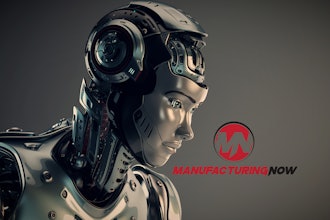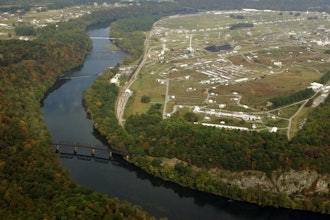Robot Workers Take Over the Job Site
Joblessness is falling, skilled workers are becoming harder to find and some American employers could be running out of skilled people to hire. It's one of those good/bad problems to have in a nation. Well, Japan has a similar issue as the country faces an aging population and declining birth rates that will lead to labor shortages across the board.
When it comes being short handed in the construction industry, Japan's National Institute of Advanced Industrial Science and Technology (AIST), has turned to robots to fill in the gaps.
Researchers recently unveiled the Human Robotics Platform (HRP)-5P prototype robot, which can perform tasks that are typically found on the job site, such as picking up a piece of drywall from a stack, moving it into position and and anchoring it to a wall. The HRP-5P is capable, but the prototype is incredibly slow and seeming thrown off balance every time it drives a screw.
The HRP-5P is nearly six-feet tall (182 cm) and weighs about 223 pounds (101 kg). The prototype is being designed to work autonomously at large structure assembly sites. Researchers have worked to improve the robot's ability to recognize and use objects, measure an environment, and they gave it a wider range of motion, including whole-body motion planning and control technology.
According to the researchers, the applications don't end at the construction site, as the technology could also be used to build aircraft and ships. Robots could also be a safer option as laborers at these job sites regularly carry out dangerous (and heavy) work.
AIST has been in the humanoid robotics game for awhile, the HRP program dates back to the HRP-1 built back in 1998 — they just tried to get that one to walk.
The HRP-2 not only improve bipedal walking, but also the ability to lie down and stand up.
The HRP-3 ushered in remote control, the ability to navigate slippery surfaces and to perform simple tasks like fastening a bolt. And the the HRP-4C, which was built for the entertainment industry, is a bit of a departure as it was developed to look like a young Japanese female that can make facial expressions, gestures and can even talk.
AIST researchers are developing humanoid robots because job sites haven't, and likely won’t, change in the near future. Even though industries struggle to find human workers, they're not exactly changing the job site to accommodate autonomous robot workers. Once the humanoid robots get up to speed, they will essentially be a plug-and-play solution.
Ford Puts Graphene Under the Hood in Mustangs, F-150s
Yesterday, we celebrated National Nanotechnology Day. It's a real thing, had a hashtag and everything: #NationalNanoDay. The date 10/9 is actually significant, as the National Nanotechnology Initiative chose it because it pays homage to the nanometer scale 10-9 meters power, or one billionth of a meter.
MIT made an elevator button, but nobody shrank — not even a timely cut to Innerspace. The Molecular Foundry made a mascot for kids, Nancy Nano, which looks like an animated STD, and Ford used the occasion to announce that for the first time in company history, it is using graphene under the hood.
Ford collaborated with Eagle Industries and XG Sciences to find a way to use small amounts, less than a half percent, of graphene in fuel rail covers, pump covers and front engine covers. While it's not cost-effective to use it in all applications, it is a very thin and flexible material that can provide a sound barrier and help make the parts lighter but more durable.
Noise reduction is particularly attractive, as attempts to reduce cabin noise in the vehicle usually means adding material and weight. When engineers mixed the graphene with foam, tests showed a 17 percent reduction in noise, a 20 percent improvement in mechanical properties and a 30 percent improvement in heat endurance properties.
Engineers have called it a "miracle material" because it is 200 times stronger than steel and extremely conductive. The material stands to play a significant role in the automotive industry, particularly in paint, polymer and battery applications.
By the end of 2018, graphene will go into production on more than 10 components under the hood on the Ford F-150 and Mustang. According to the company, the tech will eventually be rolled out on other Ford vehicles.
Japan’s New Bullet Train to Reach 250 mph
While the nation is working hard to replace the laborer with humanoid robots, Japan is also well known for its progressive approach to mass transit, and it's commitment to the bullet train.
Last week, the East Japan Railway Company (JR-EAST) announced plans for an experimental new train that could begin testing as soon as May 2019. They call it the ALFA-X and they’re going to push the prototype to see if it is capable of reaching nearly 250 mph (400 km/h). Once in service, it would average 224 mph (360 km/h).
The ALFA-X will test two new nose designs, one that is 16 m long and another that is 22 m long. The noses were developed to reduce the pressure generated when the bullet train enters a tunnel at high speeds. With both designs, the trains trade interior space for improved performance and lower noise.
The design also incorporates lighter materials and new vibration damping components that make the ALFA-X more efficient and hopefully provide a smoother ride for passengers.
JR-EAST also incorporated new earthquake detection technology such as "anti-earthquake dampers" which help keep the train stable when the earth starts shaking.
The fastest train in America, the Amtrak from Boston to D.C., averages 68 mph, though it does top out at 150 mph along a few stretches. Still, a far cry from the ALFA-X.
This is Engineering By Design.






















